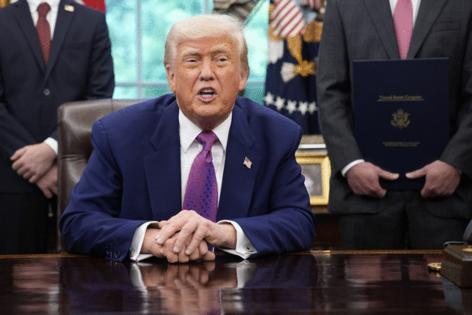Trump's diplomatic frenzy spins big gambles as signs of success
Published in Political News
It was the kind of week that would make even a seasoned diplomat’s head spin: China trade talks, India-Pakistan truce, a ceasefire with the Houthis and Iran nuclear negotiations. Not to mention a Gaza hostage release, new trade framework with the U.K. and the tantalizing prospect of ending Russia’s war in Ukraine.
For President Donald Trump’s boosters, these are proof that his hard-charging America First foreign and trade policies are yielding results better and faster than his predecessors could only imagine.
At the same time, crucial elements remain unresolved on Iran as well as Ukraine, with Russia so far balking at a ceasefire, while India has disputed some U.S. claims about its role in mediation efforts. Along with other norms, Trump’s White House has jettisoned the diplomatic tradition of quietly building consensus among allies or between adversaries, opting instead to negotiate in public and in real time.
Taken together, the latest moves reveal a White House eager to show it has momentum to pivot from a volatile first 100 days — marked by global market turmoil over tariffs — toward elusive resolutions to conflicts that Trump had promised to easily solve if he were granted a second term.
“There’s a common thread, which is a desire for a telegenic deal, almost irrespective of what the terms of the deal are,” said Kori Schake, a senior fellow at the American Enterprise Institute, who served in the George W. Bush administration.
“They’re not plotting through a 12-stage process toward peace in Gaza” for instance, Schake said. “They’re just throwing a hat in the air and shooting at it, and seeing how people respond to it.”
On Monday, Trump touted the results of Treasury Secretary Scott Bessent’s trade talks with China in Switzerland over the weekend as a “total reset.” He didn’t, however, highlight that the de-escalation on tariffs ended up meeting nearly all of Beijing’s core demands and still leaves the world’s top economies at odds over a trade war he started.
A State Department spokesperson said Trump had brought the world closer to peace than ever before in conflicts that have lasted generations. James Hewitt, a spokesman for the National Security Council, said voters had “entrusted him to deliver on advancing American interests.”
“President Trump is a man of action not bureaucracy,” Hewitt said.
Proponents of the president’s style see it as a willingness to try new approaches to solve challenges like the Russian invasion of Ukraine or the conflict between Israel and Hamas.
Trump since January “has really broken the mold of the foreign policy establishment in dealing with some very difficult global challenges that other leaders, especially President Biden and his administration, were unable to deal with,” said Fred Fleitz, who served on the White House National Security Council in Trump’s first administration and is now vice chairman of the Center for American Security at the Trump-loyal America First Policy Institute.
Trump’s unorthodox style was apparent even before he took office, sending his main negotiator, real estate investor Steve Witkoff, to engage in talks for a temporary Gaza ceasefire. Witkoff has since become the point person for negotiating the war in Ukraine and Iran’s nuclear program, taking over high stakes issues that would traditionally fall to the secretary of State and the White House national security adviser.
As for his efforts to end wars in Ukraine and Gaza, “at this point there’s still more potential than delivery,” said Dennis Ross, who served as the White House’s Middle East envoy under President Bill Clinton and is now a fellow at the Washington Institute for Near East Policy. For Trump, “business and transactions come first and doing what he defines as being in America’s interest comes first.”
Some dynamics of the Middle East developments are connected, with Trump’s upcoming trip to Saudi Arabia, the United Arab Emirates and Qatar accelerating them, according to Vali Nasr, a former adviser to the U.S. State Department and professor at Johns Hopkins School of Advanced International Studies.
For instance, he said, the Houthi deal, which Saudi Arabia aided, was seen by both Tehran and Washington as necessary to move forward their nuclear talks. As well, the Houthi ceasefire was “important to Qatar-U.S. negotiations on Gaza and as necessary calm for Trump to visit to the region.”
Even longtime ally Israel was taken by surprise. A negotiation to end the Houthis targeting of ships in the waters near Yemen covered only American vessels, although Israel is the main target. And Hamas’s release of a U.S. hostage, Edan Alexander, on Monday was greeted with relief and frustration in Israel, as it seemed to place the fate of someone with American citizenship above that of other Israelis.
Trump is also more comfortable than most of his predecessors openly weaving together geopolitics and business, lining up tariff threats or big-ticket investments alongside ceasefire negotiations between Ukraine and Russia.
“We’re using the comprehensive leverage of the United States to get better deals, better outcomes for the United States,” said Brent Sadler, a senior research fellow at the conservative Heritage Foundation.
That was the framework the Trump administration used for the India-Pakistan conflict. The president was clear he would use trade and tariffs to help quell a flareup between the two countries.
“If you don’t stop it, we’re not going to do any trade,” Trump said Monday at the White House, recalling his administration’s outreach to both sides. “And all of a sudden they said, ‘I think we’re going to stop.’ And they have. And they did it for a lot of reasons, but trade is a big one.”
“People have never really used trade the way I used it, that I can tell you,” Trump said.
©2025 Bloomberg L.P. Visit bloomberg.com. Distributed by Tribune Content Agency, LLC.




























































Comments